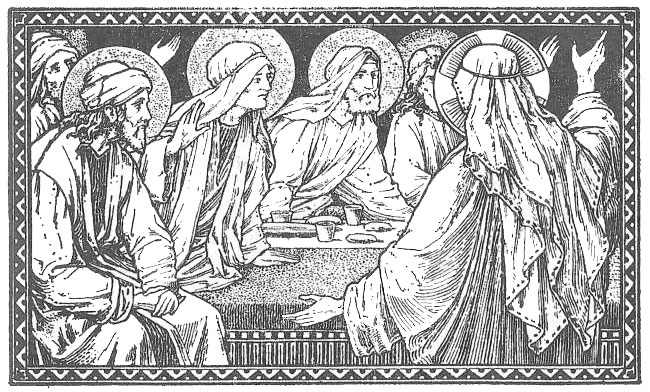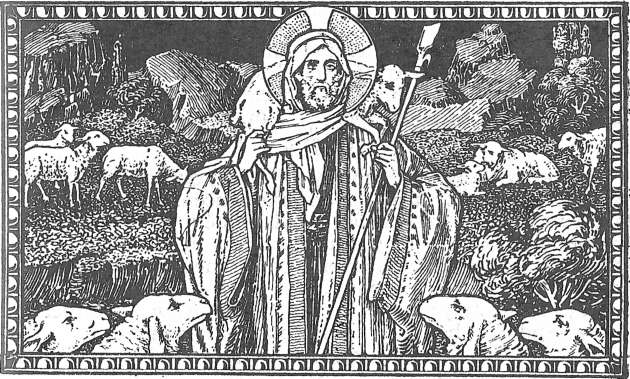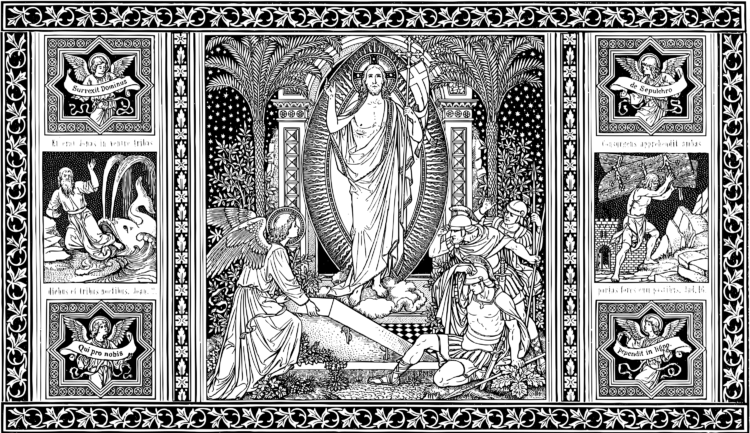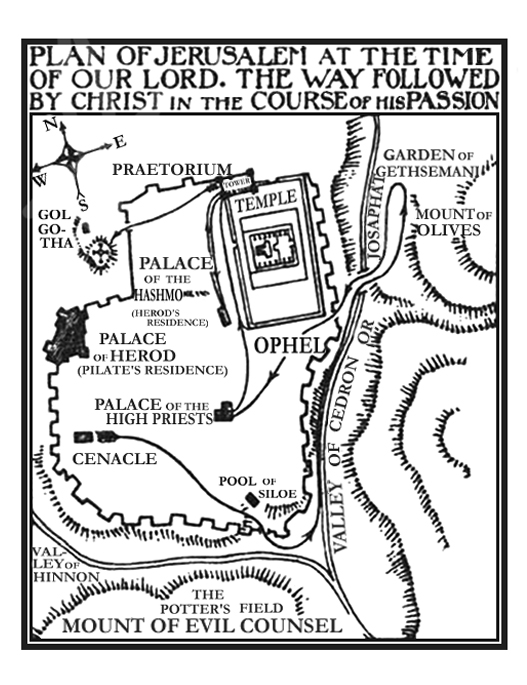Paschaltide
Third Sunday after Easter

When the apostles beheld their Lord again, they were filled with the same joy which overflows into the Easter liturgy. As Easter is but a figure of the eternal Pasch, the Church will experience a similar joy when, having with sorrow begotten souls to God, she sees Jesus once more, triumphant in heaven, at the end of time. “He will turn our sorrow into joy, which no man shall take from us.”
To possess that eternal joy, we must live in conformity with our name of Christians and observe the precepts which St. Peter enumerates in the Epistle.
Second Sunday after Easter or Good Shepherd Sunday

Today is called Good Shepherd Sunday. St. Peter, whom the risen Lord has made chief-pastor of His Church, tells us in the Epistle, that Jesus is the shepherd of our souls.
The Gospel relates the parable of the good shepherd, who protects his sheep from the attacks of the wolf and rescues them from death (Collect). It also foretells that there will be one day only one fold and one shepherd.
Low Sunday or Octave of Easter

Low Sunday, so called perhaps in contrast to the great Easter solemnity is also known as Quasimodo, from the first words of the Introit; also as Dominica in alibis, or originally post albas, i.e. after the deposition of the white garments. The Introit is taken from the Epistle of yesterday. Today’s Epistle speaks of the faith which the neophytes will have to profess.
The Gospel further shows us how Christ, who twice appeared in the Cenacle, dispelled the doubts of Thomas and praised those who, without having seen Him, should yet believe in Him.
Easter Sunday

Too often, we get excited about things, and then they come and go. What we need to do is to tear down some walls, so that that influx of grace that comes with this wonderful season of Easter, with these facts from over 2000 years ago—He is risen from the dead, the gates of Heaven are open, we have the Church—actually change our lives. It is not for us to be merely spectators in salvation history. Christ died to take away all the debt that we owe for all of our sins. Things are fundamentally changed. We need to remember this and live as though we believe that they are.
Before all else, the risen Christ offers the homage of His gratitude to His Father in heaven (Introit). In her turn the Church gives thanks to God inasmuch by the victory of His Son, He has reopened the way to Heaven, and implores Him to assist us that we may attain this our final goal (Collect). For this, Saint Paul tells us, just as the Jews eat the Paschal Lamb with unleavened bread, so we must feast on the Lamb of God, with the unleavened bread of sincerity and truth (Epistle and Communion), that is free from the leaven of sin. In the Gospel and the Offertory we read of the coming of the holy women to the sepulcher to embalm our Lord. They find an empty tomb but an angel proclaims to them the great mystery of the resurrection.
Paschaltide
Paschaltide, extending from Easter Sunday to Saturday after Pentecost, commemorates the three glorious mysteries of the Resurrection of our Lord (celebrated during forty days), of his Ascension (during ten days) and of the Descent of the Holy Ghost (during the Octave of Pentecost). Therefore, the Doctrinal, Historical, and Liturgical Notes for Paschaltide will be given in three parts, respectively before each one of the three feasts of Easter, the Ascension, and Pentecost.
The First Mystery of Paschaltide: The Resurrection

The triumph of Christ, the Vanquisher of death, is the central event of the whole of history, the culminating point of the Church’s life in her liturgical cycle, the most glorious event in His whole earthly course, the most striking proof of His divinity, and the foundation of our whole Faith.
For the Pasch of Christ, that is His passage from death to life and from earth to Heaven, finally sealed the victory which He had gained over the devil, the world, and the flesh. It was for this that the Word became Incarnate, suffered and died. The power of this holy mystery is at work in the faithful through their whole life and more especially at Easter, to make them pass from sin to grace and later on from grace to glory. For if God became man (Christmas) it was to make us gods (Easter). Just as at Christmas it was necessary for us to be born with Christ to His new life, so at Easter our souls must follow Him in the glorious life which He is beginning.
Further, Easter Week was the Feast of the Baptized, when the Church concentrating all her maternal care upon those whom St. Paul calls “her new-born babes”, strengthened them by giving them for seven days, together with the Holy Eucharist, instructions bearing upon the resurrection, the model of our supernatural life.
Paschaltide bears the character of a time of renewal. Corresponding to the Forty Days after our Lord’s resurrection during which He built up His Church, it reminds us more especially of the infant Church herself; which is the reason why at this time, the Acts of the Apostles are read in the Epistles at Holy Mass.
Every year the Easter Cycle calls up the memory of our Baptism, our First Communion, and our Confirmation and ought to penetrate us more and more with this new life. Paschaltide is a reflection of heaven; and the Church, who at Passiontide wept over our Lord and over sinners, has now a double reason for rejoicing, for Christ is risen, and to herself many children are born.
This Easter joy is a foretaste of our own resurrection and of our entry into the heavenly country where the Master is gone to prepare a place, and whither the Holy Ghost, whom He has sent to us, will lead us.
Historical Note for Easter
In the liturgy for Paschaltide, we follow our Lord in His different appearances: near the Holy Sepulcher, at Emmaus, at the Cenacle, and in Galilee. We see Him laying the foundation of His Church and preparing His disciples for the mystery of His ascension. On the day after the Sabbath, while it was still night, Mary Magdalen and two others of the holy women went to the sepulcher, reaching it at sunrise.

An angel had come and rolled away the great stone which closed the tomb, and the terrified guards had fled. Mary Magdalen, seeing that the tomb lay open, hastened to Jerusalem to tell Peter and John, while the angel was informing two more of the holy women of our Lord’s rising from the dead.1 The two disciples came running to the sepulcher which was located close to Golgotha (see map), and satisfied themselves that our Lord was not there.2 Mary Magdalen, having returned to the tomb, was the first to see our Lord after His resurrection.3 Towards evening, the two disciples who were on their way to Emmaus also saw the risen Christ, and returned at once to inform the apostles and were told the Lord had appeared to Peter.4
In the evening of the same day, Christ showed Himself to His disciples, who were gathered together at the Cenacle,5 eight days later He appeared again, convincing Thomas who had doubted until then.6
Shortly after the disciples returned to Galilee. One day, when seven of them were fishing in the Lake of Genesareth, our Lord appeared to the again.7 Moreover, He showed Himself to five hundred disciples on a mountain which He had named to them. Perhaps, this was Mount Thabor, or more probably, a hill by the lakeside, such as the Mount of Beatitudes.8 In the Gospel for the second Sunday after Easter is read the parable of the Good Shepherd, spoken by our Lord in the third year of His ministry, during the Feast of Tabernacles at Jerusalem. The Gospels for the three following Sundays are drawn from our Lord’s discourse at the Last Supper, as given by St. John.
Liturgical Note for Easter
The date of Easter, by which all the movable feasts are regulated, has been the subject of more than one solemn conciliar decree. Since our Lord died and rose again at the time of the Jewish Passover, and since the Mosaic rites were to give place to these mysteries of which they were no more than the type, the Church has kept the Jewish method of reckoning, so far as Easter is concerned. The Council of Nicea decreed that the feast should always be kept on the Sunday following the full moon after the 21st of March: this Sunday may vary between March 22 and April 25.
During Paschaltide, the Church decorates her sanctuaries and joyous harmonies of the organ are poured forth. For the chant, Asperges me is at Mass is substituted with the Vidi Aquam in which allusion is made to the waters of Baptism Certain prayers like the antiphon Regina Caeli, are said standing as befits those who triumph, and during these forty days, fasting is forbidden by the Church,9 who forgetting earth, raises the official chant of gladness which St. John tells us he heard in heaven: Introit, antiphon, verse, response, everything is followed by that enthusiastic refrain that was also buried since Septuagesima, but rose again in the Mass on Holy Saturday: “Alleluia, Alleluia, Alleluia.”
Until the Ascension, the Paschal candle, the symbol of our Lord’s visible presence upon earth, shines, and white vestments are used. “Show in your conduct the innocence which is symbolized by the whiteness of your vestments,” said St. Augustine to the neophytes, who were clothed in albs during the whole of the Easter octave. The collect “Defend us” is suppressed, and apostles and martyrs have a special Mass, being more intimately associated with the struggle and the victory of Christ. Especially the martyrs, in this part of the cycle, are the company of the risen Lord.
- See the Gospel for Easter Sunday.
- Gospel for Low Sunday
- Easter Thursday
- Easter Monday
- Easter Tuesday
- Low Sunday
- Easter Wednesday
- Easter Friday
- Since Saturday is a weekly reminder of the Paschal mystery, these two practices are observed on Sundays throughout the year.